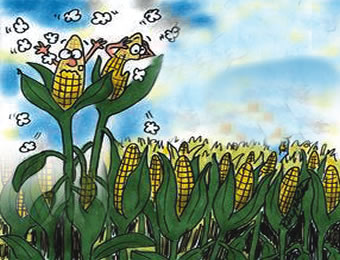G ENETIC modification of food has over the years been a controversial issue with stances that swing from approval to disapproval. Unfortunately, ignorance and illusion have informed the choices of many who now confuse molecular genetics for molecular politics. Hence, the determinate distrust and preemptive attacks on genetically modified foods abound.
Subsistence and commercial agriculture have been faced with various unfavourable conditions militating against global food production and security. However, farmers, from time immemorial, have consciously or unconsciously employed selective breeding as a simple form of genetic modification to improve yield and biotic potential. In tandem with new agricultural methods, plant breeders have applied a variety of new technologies in both developed and developing countries. Plant breeding, conventionally, is often understood as the selection of a particular – desirable – individual from a great variety of naturally occurring types of plants. It also involves the systematic interbreeding of naturally existing plants. Similarly, breeding techniques, such as wide-crossing have led to the production of hybrids.
Another technique, mutation breeding, involves the use of radiation or chemical substances to alter plants and seeds on demand. In this regard, genetic modification, also called genetic engineering, can be referred to as an improvised means to achieve same end, as it promotes much faster and more precise methods of multiplying and producing improved crops, which makes it a distinguished scheme. Nonetheless, some concerns surround the technique of genetic modification, as well as its uncertain risks, although, conventional plant breeding is not immune from unintended effects.
Genetic modification actually enables the deliberate insertion of genes from unrelated species into organisms in order to amplify, preserve or suppress identified traits. Normally, splicing – combination or insertion of genes – is done in the laboratory, before it undergoes field trial, then introduced to interested farmers, with or without explicit conditions. Most commonly, objections from many people is based on the ethical notion that it is unacceptable to splice genes. Underlying this position is the overbearing impression that nature commands an already balanced order, and thus deserves to be unmodified.
Human efforts to modify food crops are not new. Indeed, human intervention affects any system one can think of. It is invalid to presume order as static, because order is not an exception to the constant nature of change. As a matter of fact, biodiversity is subject to evolution, and there is an element of modification in every spontaneous generation of food and non-food crops. Genetics is a key enabling technology of the twenty-first century. Its importance ranks with information technology, material technology, and energy technology. The effects of these enabling technologies cuts across business and societal infrastructure, but developments in genetics, in particular, is fundamental to science and technology, including health, food and agriculture. It is therefore difficult to assure that nature should not be altered.
Despite the indispensable nature of food and nutrition, food security has not thrived in Nigeria. This, in part, is due to the feeble progress in the fight against hunger and malnutrition. Better access and availability of food cannot be wished away if this battle must be won. Unfortunately, the will – political and apolitical – to mend the ills of a gross lack of food is weak. Statistics have made it evident that a worrisome number of people, especially children, are affected by the stranglehold of hunger and malnutrition. A simple approach to tackle this would be to utilise opportunities to increase food production, availability, and access.
When yield is high, farmers are happy and motivated to produce more. On the other hand, suboptimal harvests result in a ritual of poverty, undernutrition and poor economic development. Food production is dependent on factors, including pests, disease, soil conditions, or abiotic stresses which influence the outcome of produce. Significant interventions can be accomplished through simple and popular means like irrigation, as well as application of pesticides, insecticides and fertilizer. However, these means are usually cost-intensive. The purpose of genetic modification is to be wise in penny and pounds, in light of quality, yield and profit. It enables a biotechnological fix to ensure micronutrient enrichment, abiotic stress resistance, bacterial, fungal and viral resistance, pest resistance, herbicide resistance, and biopharmaceuticals, which involve the production of vaccines in crops. Amidst possible risks and consequences, the proceeds of a well-designed genetic modification, are quite substantial and sustainable.
It is expedient to prevent the threat or occurrence of hunger and malnutrition, rather than adopt a fire brigade approach to food insufficiency. No thanks to the polarity of anxiety, the genetically engineered food producers tend to overpromise, leaving the public and government with a burden of expectation and direction. Anyways, there’s an unfixed cost, honed by an inclination to blessing or blemish. An unbiased deliberation of genetically modified foods deserves a chance in Nigeria. Genetic Modification should not be hijacked on its way to reach its potential; and if we must mourn it, let it die first.
Fadipe can be reached at mayorfad@gmail.com
WATCH TOP VIDEOS FROM NIGERIAN TRIBUNE TV
- Let’s Talk About SELF-AWARENESS
- Is Your Confidence Mistaken for Pride? Let’s talk about it
- Is Etiquette About Perfection…Or Just Not Being Rude?
- Top Psychologist Reveal 3 Signs You’re Struggling With Imposter Syndrome
- Do You Pick Up Work-Related Calls at Midnight or Never? Let’s Talk About Boundaries






